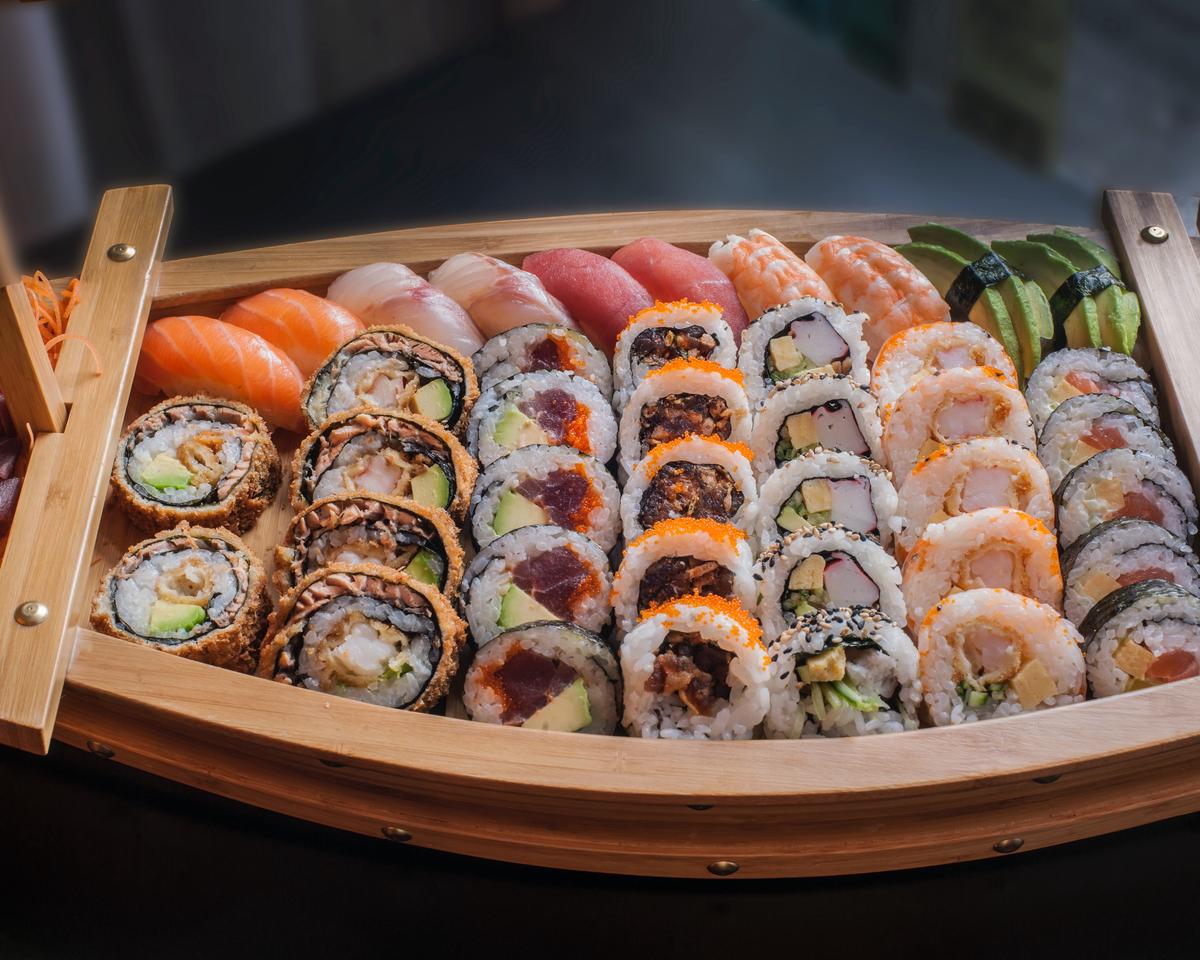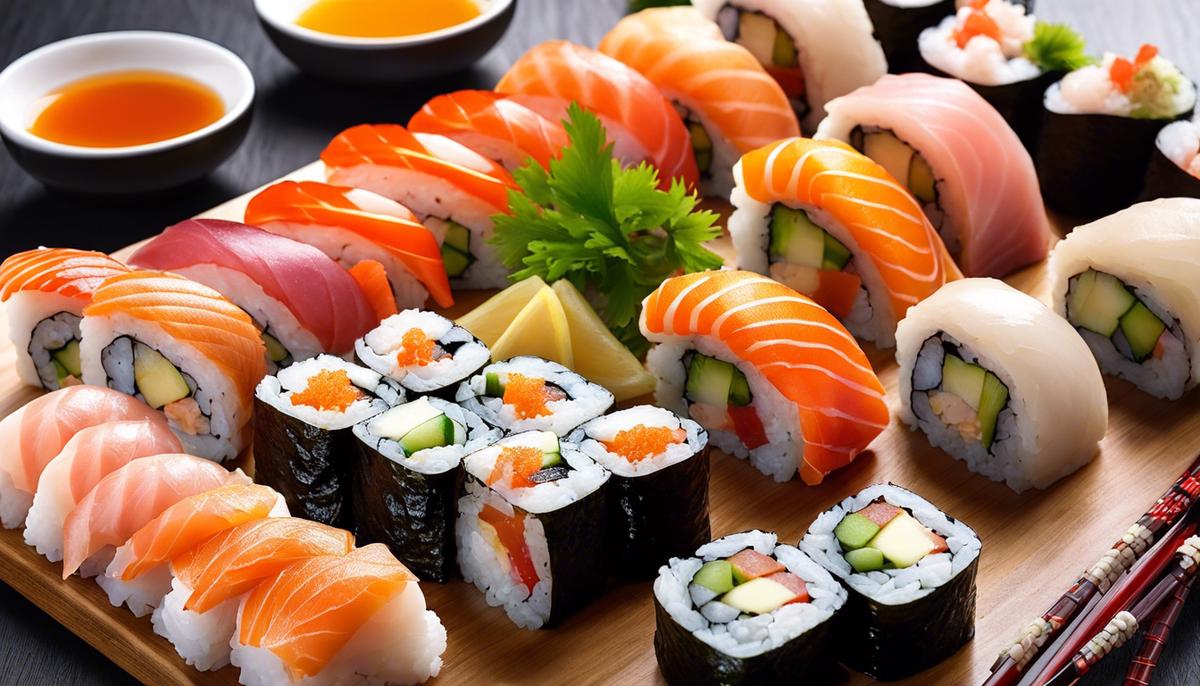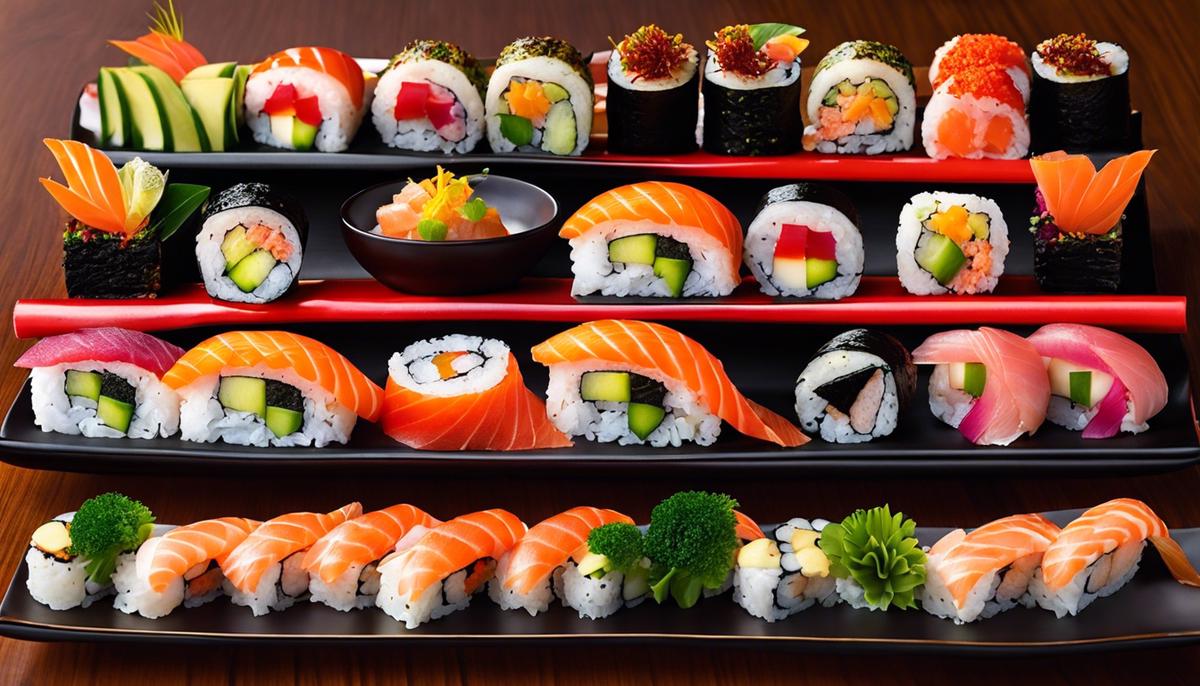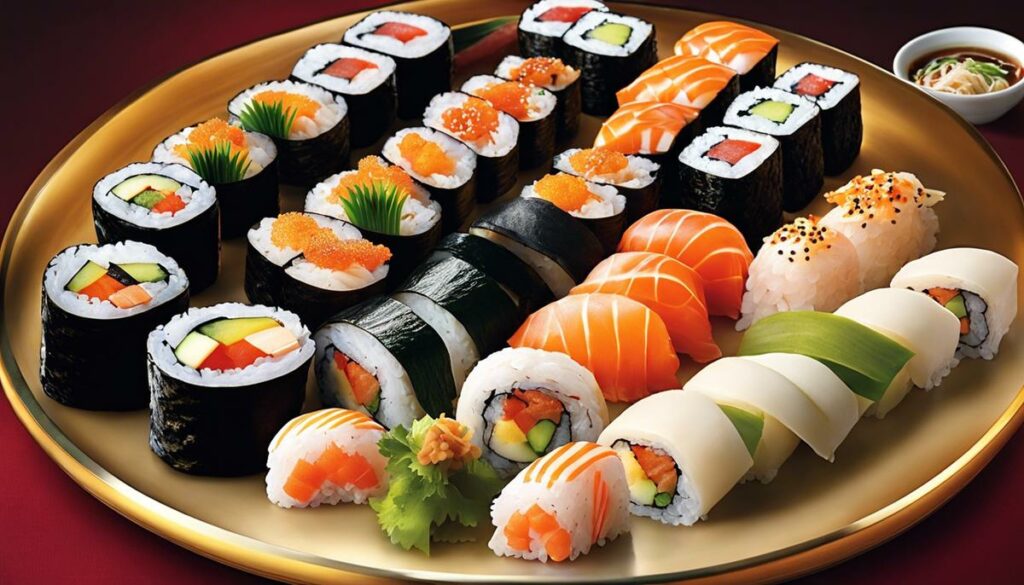Sushi, the world-famous Japanese dish, has become part of our menu far beyond the borders of its home country. The subtle artistry with which it is made, its diverse shapes and flavors, and the etiquette that accompanies it, has made it one of the most popular gourmet cuisines in the modern world. However, sushi is more than just “rice with fish”. Behind it hides an extensive history, an abundance of forms and methods of its production, and a remarkable range of health benefits. In this journey, we will delve into the exciting world of sushi and uncover the aspects that make it so surprising and unique.
The History of Sushi
In the colorful and ever-evolving world of food, sushi has become a global phenomenon that has expanded far beyond its Japanese roots. But how did this humble delicacy, once intended as a simple street food, become a global sensation?
Sushi originated in Southeast Asia in the 8th century as a simple method of preserving fish. Rice was fermented along with salted fish, which resulted in the fish having a longer shelf life. The rice was thrown away and only the fish was eaten – a distant idea of today’s sushi.
Later, in the 17th century, the Japanese began to use sushi not only as a method of preservation, but also as a stimulant. Instead of throwing away the rice, it was eaten together with the fish. However, this type of sushi was still far from sushi as we know it today. It was a rather rustic street food that was made and consumed quickly and cheaply.
It wasn’t until the 19th century that a sushi merchant named Hanaya Yohei invented what we now call modern sushi. This spectacular creation, which combines fresh fish and chilled rice, has taken the globe by storm, transforming street food into a sophisticated delicacy found in fine dining restaurants.
With the advent of globalization in the 20th century, sushi spread rapidly across the world. Its fine taste, simple ingredients, and attractive aesthetics made it a favorite dish for many people. Celebrities and influencers have also contributed to the popularity of sushi by incorporating it into their lifestyle and touting it as a trendy and healthy food.
Today, sushi is much more than just a meal. It is a symbol of the success-oriented lifestyle that many of us aspire to. It represents a sophisticated taste, a taste for beauty, and an appreciation for the company of like-minded people.
After all, the development of sushi is a story of change and adaptation, progress and innovation. It’s an example of how a simple dish with humble beginnings can become a worldwide sensation through creativity, determination, and a bit of luck. And an inspiration on how we too can shape our lives according to our own rules.

Different types of sushi
If you walk into a sushi restaurant and look at the diverse selection on the menu, it could be easy to get overwhelmed. From maki to nigiri, sashimi to temaki, Japanese cuisine is full of artful and tasty creations. But what distinguishes all these forms of sushi and which varieties are really worth trying?
In the world of sushi, each piece has its own personality. Maki rolls are probably the most well-known variety, characterized by their round shape and seaweed shell. This compact sushi style is effortless to enjoy and is perfect for sushi newbies.
Nigiri surprises with its simplicity. This is a meticulously shaped portion of rice, topped with fresh, raw seafood. A delight for lovers of raw fish.
Sashimi, as the third form, consists entirely of raw fish, without the distinctive sticky rice. This is the ideal companion for all those who appreciate the pure taste of fish.
Temaki, also known as “hand-sized” sushi, boasts an ice cream cone-like packaging. It delivers a comfortable and sociable sushi experience.
When it comes to exquisite sushi varieties, don’t miss the chance to try fugu (blowfish) if it’s on the menu. It is special not only because of its rarity and exquisite taste, but also because of the precision and expertise needed to prepare it.
Another highlight is the king crab nigiri. With its rich and buttery taste, it makes the hearts of all seafood lovers beat faster.
Sushi is often seen as an integral part of a luxurious and trendy lifestyle, but it’s much more than that. It speaks of the ability to honor centuries-old traditions while making room for creativity and innovation. Sushi is an aesthetic, an art form, and a manifestation of taste and enjoyment. So, why not try a new type of sushi and experience this seductively delicious journey of taste for yourself?

The process of making sushi
– Artful Creation: Sushi Masterpieces
Take a culinary journey into the world of sushi art form. Mere craftsmanship? Far from it! It takes years of experience and training to become a sushi master. It’s all about finely chopping, rolling precisely, and setting creatively to create the ultimate masterpiece.
– The expression of an aesthetic vision
Sushi plays a central role in the aesthetics of Japanese cuisine. Whether it’s traditional or experimental, the presentation, textures, and colors are key. Insiders know it’s not just about taste. It’s a sensual, almost meditative experience.
– Secret Ingredients: Quality and Freshness
The quality of the ingredients is the secret of a good sushi. Only the best of the best is selected. Fish of the highest freshness, carefully selected and precisely cut, is the hallmark of a good sushi.
– Sake, Wasabi, Ginger and More: The Casual Players
When it comes to eating sushi, there’s more to it than just the starring role. A good sake, a spicy wasabi or pickled ginger can elevate the taste experience to a higher level. They accentuate and complement the main ingredients and create a well-rounded taste experience.
— Elegance on the Tongue: The Right Way to Eat Sushi
There are right and wrong ways to eat sushi. Yes, it’s true! It starts with the handling of the chopsticks and continues into the soy sauce until the dipping process. Sushi masters will tell you that the fish – not the rice – is dipped in the soy sauce.
Come into the world of sushi. Discover the hidden beauty and irresistible pleasure. But beware: it could easily become an obsession. Why? Simply because sushi is more than just a dish. It’s a way of life.

The etiquette surrounding eating sushi
Sushi – It is more than just a dish, it is an artful representation and embodiment of highly aesthetic visions, a manifestation of passion and finesse in preparation. Each creation is a tribute to the freshness and quality of the ingredients, a glamorous representation of a Gusto poem. The composition is so crucial that it opens up a universe of its own in every bite.
In addition to the high quality of the ingredients, the role of the accompanying flavors and spices also plays a central role in the sushi culture. They underline and complement the effect of the main ingredients, creating harmony and a holistic touch. The wasabi, essential and indispensable, resembles a sharp note that recalls the heart of Japanese cuisine.
But how do you enjoy your sushi in an authentically Japanese way? Here are a few tips: Flip the nigiri sushi over and dip it so that only the fish touches the soy sauce. Do this carefully so that the rice does not fall apart. If chopsticks are used, she is treated respectfully and mindfully. Pushing and scratching with the chopsticks is considered rude.
So get out there and enjoy the hidden beauty and irresistible pleasure that sushi offers, because how could you resist such a treat? A dish that is both handsome and irresistibly tasty, a delicious sculpture that seduces the eye as much as it delights the palate.
Sushi isn’t just a fashion phenomenon, it’s an obsession that can become a lifestyle. It’s a culinary galaxy waiting to be explored. Forget bread and butter, the new gold standard for the discerning palate is sushi! It appeals to the senses and elevates the culinary experience to a new dimension. So, go and conquer your taste buds with sushi, the star on your menu!
However, in this tasty universe, we remember one very important thing: respect sushi and its traditions, just as it has been respected and revered for centuries. Only then will we continue to enjoy it, with its unique charm and irresistible taste.

The Health Benefits of Sushi
Despite sushi’s global popularity, the mystery of the traditional sushi experience often remains unexplored. Sushi’s aesthetics and philosophy go far beyond its delicious flavors and visual appeals. It is an art form defined by the beauty and precision of its creation. It is also the expression of an aesthetic vision and the epitome of culinary refinement.
The freshness and quality of the ingredients play a crucial role in the sushi experience. The first bite immediately reveals the difference between exquisite, high-quality ingredients and those that don’t live up to the standard. The rich variety of flavors in a piece of sushi is created by the harmonious balance between the fish, the rice and the soy sauce. Simple, but impressive!
Consider, for example, the composition of a piece of sushi: the sushi master strives for a balance of tastes, textures, and even colors. The fine art of sushi is to achieve harmony between the components, where neither ingredient dominates the other. It is these nuanced details that deserve the respect and admiration of heritage.
Wasabi and ginger, the typical accompaniments of sushi, play a bigger role than you might think. Wasabi cuts the fatness of the fish and thus brings out the flavor, while the pickled ginger helps to cleanse the palate between different pieces of sushi.
Sushi tasting is all about enjoying an authentic Japanese experience. Therefore, it is important to follow some rules. For example, that nigiri is eaten by hand and not with chopsticks, or that soy sauce is used sparingly.
Sushi is not just a dish, but a philosophy of life that combines high-end experience and suitability for everyday use. It’s also a galaxy of culinary delights waiting to be explored.
Respecting the importance of sushi and its traditions can pave the way to a cultured and refined lifestyle. Viewing, tasting and experiencing sushi opens up new dimensions of the culinary world that set new standards for discerning gourmets.
Last but not least, sushi is more than a trend – it’s a way of life. Whether you prepare it yourself, enjoy it in a Japanese restaurant or be inspired by the countless variations, sushi appeals to the senses and adds a pinch of extravagance to the everyday routine. It transforms a simple meal into a ritual pleasure that testifies to a rich heritage and vibrant aesthetic. It embodies ultimate pleasure and always offers an opportunity to appreciate the art of gastronomic subtleties.

Sushi tasting is truly a feast for the senses. It’s a peaceful symbiosis of taste, texture, look, and etiquette that combine to create a dining experience that’s second to none. With its rich historical heritage, impressive diversity, high-quality craftsmanship in its production, and numerous health benefits, sushi is definitely an example of indulgence at the highest level. Wherever your sushi journey takes you, it’s sure to be full of surprises, new discoveries, and most importantly, delicious delights. Dive in, enjoy and experience the wonderful world of sushi in all its fullness. Enjoy your meal!


